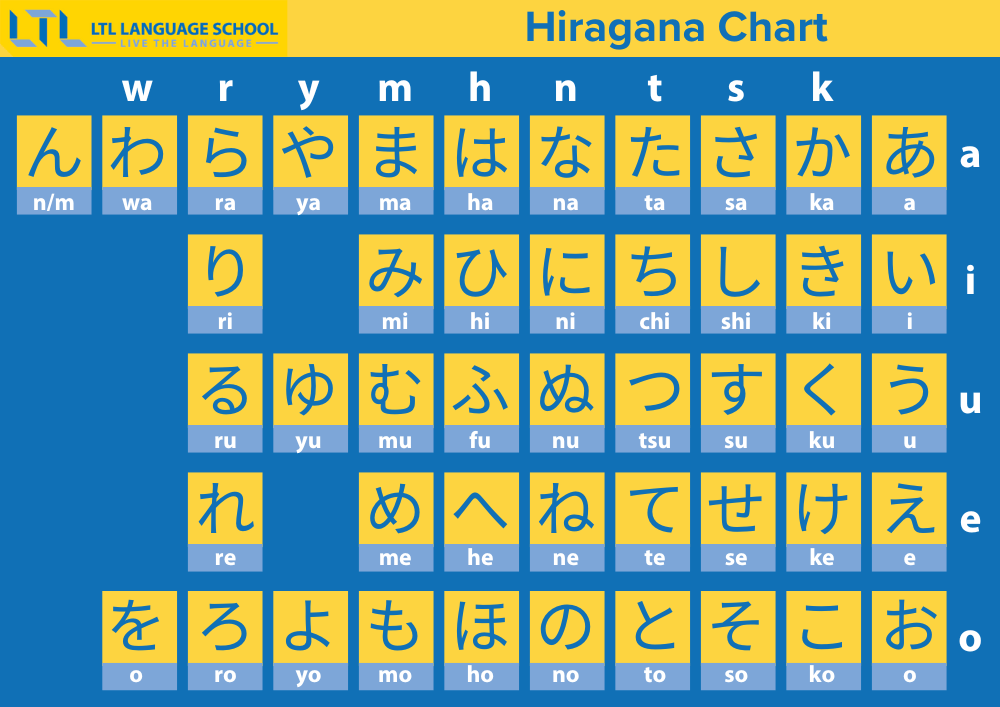A GUIDE TO KATAKANA
Katakana syllables are characterized by short, straight strokes and sharp corners.
These Katakana syllables are used to write words borrowed from other languages.
For emphasis, to represent onomatopoeia, for technical and scientific terms, and for names of plants, animals, minerals and often Japanese companies.

WHAT IS CHōONPU?
Chōonpu is a horizontal or vertical line in the centre of the text with the width of one kanji or character. It is written horizontally in horizontal text and vertically in vertical text.
The chōonpu is usually used to indicate a long vowel sound in katakana writing, and rarely in hiragana writing.
For example:
| KATAKANA | ROMANISATION | ENGLISH |
|---|---|---|
| コーヒー | kōhī | Coffee |
| ラーメン | rāmen | Japanese noodles |
Now, let’s see the Katakana syllables.
LEARNING KATAKANA || A SERIES
| KATAKANA | ROMANISATION |
|---|---|
| ア | a |
| イ | i |
| ウ | u |
| エ | e |
| オ | o |
View Some Examples:
| KATAKANA | ROMANISATION | ENGLISH |
|---|---|---|
| アパート | apāto | Apartment |
| ナイフ | naifu | Knife |
| ウール | ūru | Wool |
| エアコン | eakon | Air conditioner |
| オレンジ | orenji | Orange |
LEARNING KATAKANA || THE KA SERIES
| KATAKANA | ROMANISATION |
|---|---|
| カ | ka |
| キ | ki |
| ク | ku |
| ケ | ke |
| コ | ko |
View Some Examples:
| KATAKANA | ROMANISATION | ENGLISH |
|---|---|---|
| カメラ | kamera | Camera |
| キーボード | kībōdo | Keyboard |
| クリスマス | kurisumasu | Christmas |
| ケーキ | kēki | Cake |
| コーヒー | kōhī | Coffee |
LEARNING KATAKANA || THE SA SERIES
| KATAKANA | ROMANISATION |
|---|---|
| サ | sa |
| シ | shi |
| ス | su |
| セ | se |
| ソ | so |
View Some Examples:
| KATAKANA | ROMANISATION | ENGLISH |
|---|---|---|
| サービス | sābisu | Service |
| シルバー | shirubā | Silver |
| スマホ | sumaho | Smartphone |
| セーター | sētā | Sweater |
| ソニー | sonī | Sony |
LEARNING KATAKANA || THE TA SERIES
| KATAKANA | ROMANISATION |
|---|---|
| タ | ta |
| チ | chi |
| ツ | tsu |
| テ | te |
| ト | to |
View More Examples:
| KATAKANA | ROMANISATION | ENGLISH |
|---|---|---|
| タクシー | takushī | Taxi |
| チキン | chikin | Chicken |
| シャツ | shyatsu | Shirt |
| テレビ | terebi | Television |
| トマト | tomato | Tomato |
LEARNING KATAKANA || THE NA SERIES
| KATAKANA | ROMANISATION |
|---|---|
| ナ | na |
| ニ | ni |
| ヌ | nu |
| ネ | ne |
| ノ | no |
View More Examples:
| KATAKANA | ROMANISATION | ENGLISH |
|---|---|---|
| バナナ | banana | Banana |
| アニメ | anime | Anime |
| スーパー | sūpā | Supermarket |
| ネットワーク | nettowāku | Network |
| ノート | nōto | Notebook |
LEARNING KATAKANA || THE HA SERIES
| KATAKANA | ROMANISATION |
|---|---|
| ハ | ha |
| ヒ | hi |
| フ | fu |
| ヘ | he |
| ホ | ho |
View More Examples:
| KATAKANA | ROMANISATION | ENGLISH |
|---|---|---|
| ハンカチ | hankachi | Handkerchief |
| ヒーター | hītā | Heater |
| ファイル | fairu | File |
| ヘルメット | herumetto | Helmet |
| ホテル | hoteru | Hotel |
LEARNING KATAKANA || THE MA SERIES
| KATAKANA | ROMANISATION |
|---|---|
| マ | ma |
| ミ | mi |
| ム | mu |
| メ | me |
| モ | mo |
View More Examples:
| KATAKANA | ROMANISATION | ENGLISH |
|---|---|---|
| マンガ | manga | Manga |
| ミルク | miruku | Milk |
| ムービー | mūbī | Movie |
| メール | mēru | |
| モデル | moderu | Model |
LEARNING KATAKANA || THE YA SERIES
| KATAKANA | ROMANISATION |
|---|---|
| ヤ | ya |
| ユ | yu |
| ヨ | yo |
Here are some words from the ‘Ya’ series:
| KATAKANA | ROMANISATION | ENGLISH |
|---|---|---|
| ヤフー | yafū | Yahoo |
| ユーザー | yūzā | User |
| ヨーガ | yōga | Yoga |
LEARNING KATAKANA || THE RA SERIES
| KATAKANA | ROMANISATION |
|---|---|
| ラ | ra |
| リ | ri |
| ル | ru |
| レ | re |
| ロ | ro |
View More Examples:
| KATAKANA | ROMANISATION | ENGLISH |
|---|---|---|
| マフラー | mafurā | Muffler |
| スリッパ | surippa | Slippers |
| ルール | rūru | Rule |
| チョコレート | chyokorēto | Chocolate |
| ロッカー | rokkā | Locker |
KATAKANA LAST THREE SYLLABLES
| KATAKANA | ROMANISATION |
|---|---|
| ワ | wa |
| ヲ | wo |
| ン | nn |
Example: ワイン wainn Wine
EXTENDING KATAKANA
Combinations of small versions of the five vowels i.e., ア、イ、ウ、エ and オ are known as extended katakana.
These standard katakana symbols are used to create more accurate representations of the pronunciations of words in other languages.
For example:
| KATAKANA | ROMANISATION | ENGLISH |
|---|---|---|
| パーティー | pātī | Party |
| ファミリー | famirī | Family |
| フォーム | fōmu | Form |

ADDITIONAL SYLLABLES
USE OF DAKUTEN
| GA SERIES | ZA SERIES | DA SERIES | BA SERIES |
|---|---|---|---|
| ガ ga | ザ za | ダ da | バ ba |
| ギ gi | ジ zii | ヂ ji | ビ bi |
| グ gu | ズ zu | ヅ zu | ブ bu |
| ゲ ge | ゼ ze | デ de | ベ be |
| ゴ go | ゾ zo | ド do | ボ bo |
USE OF HANDAKUTEN
Handakuten converts the ハ (ha) series into パ = the Pa series.
| パ pa | ピ pi | プ pu | ペ pe | ポ po |
USE OF SMALL ALPHABET // SOKUON 促音
The sokuon (促音) is a symbol in the form of a small hiragana or katakana tsu.
In less formal language it is called chiisai tsu (小さいつ ) or chiisana tsu (小さなつ), meaning “small tsu“. It can never appear at the beginning of the word.
ッ is used to stress the word by doubling the consonant.
For example:
| KATAKANA | ROMANISATION | ENGLISH |
|---|---|---|
| サッカー | sakkā | Football / Soccer |
| サンドイッチ | sandoichchi | Sandwich |
OTHER SYLLABLES // YOUON 拗音
Just like Hiragana, the youon (拗音), is a combination of a katakana ending in i, such as シ (shi), with a smaller version of one of the three y kana, ya, yu or yo.
ヤ、ユ and ヨ are often used in combination with the basic syllables キ、シ、チ、ニー、ヒ、ミ、 and リ.
For example:
| KATAKANA | ROMANISATION | ENGLISH |
|---|---|---|
| シャドー | shadō | Shadow |
| ニュース | nyūsu | News |
| チョコレート | chokorēto | Chocolate |

Learn Japanese with FlexiClasses
Book online classes with the best teachers in the industry.
SIMILAR RESOURCES
Want to learn more? Check out these other free resources:
- Learn how to use Hiragana
- Learn how to use Kanji
- Learn why there are three alphabets in Japanese
FAQs
What’s the difference with Katakana & Hiragana?
Hiragana is more cursive whereas the Katakana letters are more angular in shape.
This makes it really easy to differentiate between which alphabet is being used on paper or on screen.
Here are some Hiragana – おはよう (this means good morning)
Here are some Katakana – カメラ (this means camera)
See the difference?
How many alphabets in Japanese?
Japanese has 3 alphabets which each serve different purposes.
They are:
Hiragana
Katakana
Kanji
You can find out more about the 3 Alphabets of Japanese here.
Are Kanji and Chinese characters the same?
Japanese Kanji indeed come from Chinese characters.
Be careful though!
Not only do they not have the same pronunciation, they can also hold different meanings.
Visit this article we wrote about Kanji and Hanzi you shouldn’t confuse!
Can all Japanese alphabets be included in one sentence?
Yes and most do in fact. Here is a very basic example:
私は(ゾイ)です。
This translates to “My name is Zoe” and includes all 3 of Hiragana, Katakana and Kanji
Where can I learn Katakana?
You can learn Katakana in our article right here!
Don’t forget to also check out our Top 7 Tips to Learn Katakana.
The best way to learn the Japanese alphabets, including Hiragana, would be with a native teacher.
Can I take Japanese lessons at LTL?
Yes you can!
Check out our online Japanese classes here.
You can also study in both group or individual classes in Tokyo.
All lessons are taught by professional native teachers.
TEST YOUR JLPT KNOWLEDGE
Thinking about taking the JLPTExam? Or just interested in testing your vocabulary skills?
Challenge yourself with those JLPT vocabulary quizzes, and discover how much you really know! 🔥
Each quiz contains 30 randomised questions, so you can retake it as many times as you like and receive fresh questions every time!
For even more free resources and LTL news, sign up to our LTL Monthly Newsletter.
MORE FREE LESSONS
-
Hiragana
- -
Katakana
- -
Basic sentence structures
Subject + は + Object + です -
Present tense in Japanese
食べる → 食べます -
Past tense in Japanese
Verb + た -
Continuous tense (て形 te form)
Verb + て te -
Negative sentences in Japanese
Subject + Object + ではありません -
Japanese honorifics
お / ご + します -
Dates in Japanese
Year + 年 + Month + 月 + Day + 日 -
Telling time in Japanese
Number + 時 -
How to count in Japanese
- -
Introduction to 12 Japanese counters
Number + Counter -
Using ii-adjectives and na-adjectives
Adjective + Noun + です -
How to use adverbs in Japanese
Remove い + Add く -
Plain forms verbs
Phrase + です / だ -
Making basic comparisons in Japanese
A (noun) + のほうが + B -
Asking questions in Japanese
いつ, 何時, なん, いくら, どう, どなた -
Introduction to Japanese particles
Topic + は -
Object particle を
Object + を -
Subject particle が
Subject + が -
Possessive particle の
Noun 1 + の + Noun 2 -
Adjective particle が
Subject + が + adjective -
Topic particle は
Topic + は -
Location particles に and で
Location + に -
Direction particles に and へ
Noun + に -
Japanese prepositions: in, at, on
[Object or Person] + うしろに + [Reference Point] -
How to make the Japanese Te form (て)
ある → あって -
Connecting sentences with て form
V te-form 1, V te-form 2, ~ -
How to say "with" with と, 一緒に & と共に
Noun + と -
How to say "and" with と & し
Noun 1 + と + Noun 2 -
How to say "because" with から, ので & more
なぜなら + Phrase + から / ので -
This & that with これ, それ and more
これ / それ / あれ + は何ですか? -
Expressing emphasis in Japanese
とても + Adjective / Verb -
Expressing together in Japanese
Subject + (と)一緒に + Verb -
Give & ask for directions in Japanese
これ + Noun -
Relative quantities in Japanese
- -
Expressing frequency in Japanese
いつも + verb phrase


 Hi, my name is Sabatino! I am from Italy and I am a Student Advisor at LTL. Fancy coming to study with us in Japan?
Hi, my name is Sabatino! I am from Italy and I am a Student Advisor at LTL. Fancy coming to study with us in Japan? Hi, my name is Manuel! I am from Spain and I am a Student Advisor at LTL. Fancy coming to study with us? Drop me a message.
Hi, my name is Manuel! I am from Spain and I am a Student Advisor at LTL. Fancy coming to study with us? Drop me a message.
